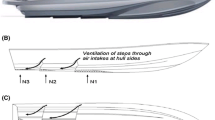Abstract
One of the methods for reducing drag is inducing a change in the shape of the body due to making longitudinal side tunnels on the hull body. In this method, the usual shape of a specific mono-hull is changed into tunneled one keeping the geometric parameters, including deadrise angle, keel line, beam width, and the hull length, constant. Various geometric parameters are effective on drag reduction of different sections of the tunnel while designing and manufacturing the hull. To obtain an optimum shape for the tunnel, this study has attempted the influence of the size of the tunnel aperture on hydrodynamic parameters of the hull. For this purpose and through considering the moving mesh, numerical simulation of the problem by means of finite volume method has been employed, using FLUENT commercial software. For turbulence modeling, k-ε model, and for simulating the free surface, the volume of fluid two phase model has been used. In addition, remeshing and smoothing methods were employed for moving mesh. The presented results show that, forming a tunnel in the base hull could cause a reduction in the total drag in high-speed planing hulls and in the vessel draft over the whole range. Furthermore, in high Froude number, a reduction in the size of the tunnel aperture (up to a specific amount) could lead to a decrease in the total drag.













Similar content being viewed by others
References
Ma W, Sun H, Zou J, Yang H (2013) Test research on the resistance performance of high-speed trimaran planing hull, Polish maritime Research, No 4/2013
Yousefi R, Shafaghat R, Shakeri R (2014) High-speed planing hull drag reduction using tunnels. Ocean Eng 84:54–60
Ghassabzadeh M, Ghassemi H (2014) Determining of the hydrodynamic forces on the multi-hull tunnel vessel in steady motion. J Braz Soc Mech Sci Eng. doi:10.1007/s40430-013-0110-2
Ghassabzadeh M, Ghassemi H (2014) Numerical hydrodynamic of multihull tunnel vessel. Open J Fluid Dyn 2013(3):198–204
Shen H, Lu W, Su Y (2013) Numerical prediction method of resistance performance of catamaran planing vessels. Appl Mech Mater 344:19–22
Muljowidodo K et al (2012) Design and simulation analysis of flying trimaran USV. Indian J Geo-Mar Sci 41(6):569–574
Yousefi R, Shafaghat R, Shakeri M (2013) Hydrodynamic analysis techniques for high-speed planing hulls. Appl Ocean Res 42:105–113
Kazemi moghadam H, Shafaghat R, Yousefi R (2014) The effect of various boundary conditions on the quality of the numerical simulation of a planning hull. In: Proceedings of the third national conference high speed vessel (in Persian)
Savitsky D (1964) Hydrodynamic analysis of planing hulls. Mar Technol 1(1):71–95
Author information
Authors and Affiliations
Corresponding author
Additional information
Technical editor: Celso Kazuyuki Morooka.
Rights and permissions
About this article
Cite this article
Kazemi Moghadam, H., Shafaghat, R. & Yousefi, R. Numerical investigation of the tunnel aperture on drag reduction in a high-speed tunneled planing hull. J Braz. Soc. Mech. Sci. Eng. 37, 1719–1730 (2015). https://doi.org/10.1007/s40430-015-0431-4
Received:
Accepted:
Published:
Issue Date:
DOI: https://doi.org/10.1007/s40430-015-0431-4




